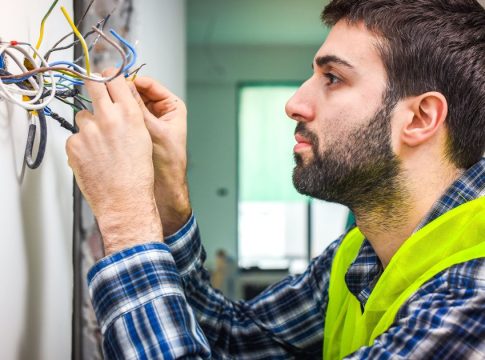Making plans and sticking to them is the key to successful wiring projects. Preparing an approach list to the entire process including a deadline is important to wiring a house. Next, complete the toolbox that will be required in this project, which will minimize the effort needed.
This toolbox should include:
- Wire connectors,
- Cables,
- Conduits,
- Continuity and voltage testers,
- Cable stripper,
- Wore stripper,
- Fish tape,
- Drills,
- Wire cutters,
- Chisel,
- Pry bar,
- Utility knife,
- Safety goggles,
- Utility lights,
- Circular saws,
- Hammers,
- Tape measures,
- Screwdrivers,
- Ladders,
- And a host of other implements that make up the long list of needed equipment.
- Determine ahead of beginning the wiring placement throughout the home by establishing a wire pathway. An efficient design that features simple mapping and lack of obtrusiveness are key to wiring success. A great tip is placing switches near doors, making them simple to locate. An average power consumption requirement evaluation is next by counting the number of electrical appliances owned, including the extensions. Voltage needs should also be included in this evaluation. These appliances include lights and other rudimentary necessities, which help in deciding circuit breaker sizes. Existing connections should also be checked for, as previous connections can be incorporated into the new setup, after checking for their proper functioning.
- Consulting existing ordinances and laws regarding wiring, contained within the NEC (National Electric Code). This embraces safety and habitable living, including circuit interrupters in damp areas such as bathrooms. Wear protection clothing such as goggles and switch off circuit breakers during all wiring endeavors. Drill holes using correct tools, while checking wall thickness. Check for fixture and switch sizes, never drilling too shallow or too deep. Check also for cable fraying, after bringing your own cables. Establishing the circuit breakers is also imperative, as circuit breaks are attached to them. Each wiring system should have one circuit breaker, to create cushioning against current or voltage overloading. All this smaller circuit breakers should be connected to a chief circuit breaker, which will be located within the chief electrical panel. This location also holds the home’s electricity supply main switch.
- Ensure the passing of safety standards by this wiring project, through testing the tools and wiring, using a tester for voltage. Other safety standards are located within the NEC, and ensure safety of residents from inherent dangers in wiring processes. Testing for proper functioning of the wiring project should be carried out prior to anybody residing in the home.
Making plans and sticking to them is the key to successful wiring projects. Preparing an approach list to the entire process including a deadline is important to wiring a house. Next, complete the toolbox that will be required in this project, which will minimize the effort needed.
This toolbox should include:
- Wire connectors,
- Cables,
- Conduits,
- Continuity and voltage testers,
- Cable stripper,
- Wore stripper,
- Fish tape,
- Drills,
- Wire cutters,
- Chisel,
- Pry bar,
- Utility knife,
- Safety goggles,
- Utility lights,
- Circular saws,
- Hammers,
- Tape measures,
- Screwdrivers,
- Ladders,
- And a host of other implements that make up the long list of needed equipment.
- Determine ahead of beginning the wiring placement throughout the home by establishing a wire pathway. An efficient design that features simple mapping and lack of obtrusiveness are key to wiring success. A great tip is placing switches near doors, making them simple to locate. An average power consumption requirement evaluation is next by counting the number of electrical appliances owned, including the extensions. Voltage needs should also be included in this evaluation. These appliances include lights and other rudimentary necessities, which help in deciding circuit breaker sizes. Existing connections should also be checked for, as previous connections can be incorporated into the new setup, after checking for their proper functioning.
- Consulting existing ordinances and laws regarding wiring, contained within the NEC (National Electric Code). This embraces safety and habitable living, including circuit interrupters in damp areas such as bathrooms. Wear protection clothing such as goggles and switch off circuit breakers during all wiring endeavors. Drill holes using correct tools, while checking wall thickness. Check for fixture and switch sizes, never drilling too shallow or too deep. Check also for cable fraying, after bringing your own cables. Establishing the circuit breakers is also imperative, as circuit breaks are attached to them. Each wiring system should have one circuit breaker, to create cushioning against current or voltage overloading. All this smaller circuit breakers should be connected to a chief circuit breaker, which will be located within the chief electrical panel. This location also holds the home’s electricity supply main switch.
- Ensure the passing of safety standards by this wiring project, through testing the tools and wiring, using a tester for voltage. Other safety standards are located within the NEC, and ensure safety of residents from inherent dangers in wiring processes. Testing for proper functioning of the wiring project should be carried out prior to anybody residing in the home.
